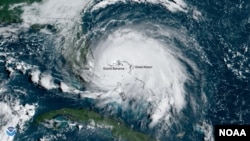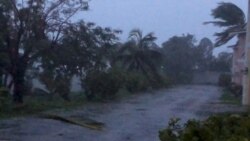Hurricane Dorian battered Grand Bahama Island on Monday as the monster storm virtually stalled, toppling and damaging thousands of homes and sending a "life-threatening storm surge" barreling across low-lying coastal lands.
Forecasters called the storm "catastrophic" and "devastating." They predicted Dorian would continue to pound the island throughout much of the day with drenching rains, as much as 60 centimeters, and winds of about 250 kilometers per hour.
The winds diminished slightly from earlier Monday, now making Dorian a Category 4 storm, downgraded from the severest Category 5 classification on the Saffir-Simpson scale of hurricane intensity.
The U.S. National Hurricane Center said the storm is continuing to slowly edge west at 2 kilometers an hour. At last report, Dorian was about 180 kilometers east of West Palm Beach, Florida.
The International Federation of Red Cross and Red Crescent Societies said an initial assessment by authorities and its officials showed extensive damage on Grand Bahama and Great Abaco islands, with as many as 13,000 houses that may have been badly damaged or destroyed. Storm surges reached seven meters above normal tide levels.
The international bank UBS estimated that the storm could cause $25 billion in damage.
There were no immediate estimates of casualties in the Bahamas, although news reports said a 7-year-old boy had drowned as a result of the storm.
Bahamian Prime Minister Hubert Minnis broke down in tears at a news conference Sunday, calling it "the worst day of my life." He said many Bahamians had not heeded warnings to evacuate, refusing to leave their homes.
"I can only say to them that I hope this is not the last time they will hear my voice," he said.
In the United States authorities ordered more than a million evacuated from coastal regions in Florida and further north in the states of Georgia and South Carolina. Nearly 1,000 flights were canceled in Florida as the storm edged closer.
Palm Beach County, Florida, home to President Donald Trump's Atlantic oceanfront resort, was among the jurisdictions ordering a partial mandatory evacuation.
"This looks like it could be larger than all of them," Trump said Sunday during a hurricane briefing in Washington at the Federal Emergency Management Agency.
The agency said Dorian "will move dangerously close to the Florida east coast" by Monday night and stay close to the shoreline through Wednesday night, and imperil coastal areas in Georgia and South Carolina Wednesday night and Thursday.
"Although gradual weakening is forecast," meteorologists said, "Dorian is expected to remain a powerful hurricane during the next couple of days."
"A slow westward to west-northwestward motion is forecast during the next day or so, followed by a gradual turn toward the northwest and north," said the National Hurricane Center in its most recent advisory. How much Dorian turns and how quickly will determine the extent of its effects on the U.S. mainland. For now, forecasters have put hurricane warnings in place for about half of Florida's east coast.
In the Bahamas, residents riding out the storm posted images of water rising up the side of their homes. The Bahamas Power and Light utility said there was a total blackout in New Providence, the archipelago's most populous island, even though it was not in the direct path of the hurricane's eye. The company said its office on Great Abaco was flattened.
Jared Moskowitz, director of the Florida Division of Emergency Management, said, "Hurricane Dorian is the strongest storm to ever threaten the state of Florida on the east coast. No matter what path this storm takes, our state will be impacted. We will continue to work around the clock to prepare."











